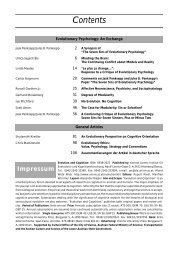Contents - Konrad Lorenz Institute
Contents - Konrad Lorenz Institute
Contents - Konrad Lorenz Institute
You also want an ePaper? Increase the reach of your titles
YUMPU automatically turns print PDFs into web optimized ePapers that Google loves.
Darwin and Descartes’ Demon<br />
tive distinction, which in turn<br />
supports the view that the belief<br />
in an objective external reality<br />
can be traced to innate<br />
aspects of mind.<br />
Conclusion<br />
Author’s address<br />
Steve Stewart-Williams, School of Psychology,<br />
Massey University, Palmerston North,<br />
New Zealand.<br />
E-mail: anonymous1@xtra.co.nz<br />
HUME (1955) said: “The mind has never anything<br />
present to it but the perceptions, and cannot possibly<br />
reach any experience of their connection with<br />
other objects” (Section XII, Part I, Paragraph 12).<br />
But despite the fact that perception alone reveals<br />
nothing about the objectivity or mind independence<br />
of the world, the common sense assumption<br />
for the majority of people is metaphysical realism.<br />
Evolutionary considerations and various lines of evidence<br />
raise the possibility that this assumption<br />
traces to innate aspects of the human mind, namely,<br />
the capacity to distinguish mental events that have<br />
objective referents from those that do not, and the<br />
capacity to represent the continued existence of unperceived<br />
parts of the world. These capacities plausibly<br />
enhanced the inclusive fitness of our ancestors.<br />
The ability to distinguish the subjective from the<br />
objective may relate to the production of appropriate<br />
behaviour in response to subjective versus objective<br />
aspects of mental experience,<br />
and may be associated<br />
with an adaptive bias toward<br />
assuming the objectivity of<br />
our perceptual and other<br />
judgements. The conscious<br />
understanding that unperceived<br />
parts of the world continue<br />
to exist may relate to tracking environmental<br />
regularities, and may be a necessary ingredient in<br />
the generation of novel adaptive behaviour. At this<br />
stage, these views are highly speculative, and the arguments<br />
and evidence provided certainly do not<br />
constitute an unassailable proof. Nonetheless, it is<br />
my view that they justify further research and discussion<br />
on this topic.<br />
Author Note<br />
This paper was supported by a Bright Future Top-<br />
Achiever Doctoral Scholarship, administered by<br />
FRST. Thanks go to Dr. Stephen HILL and Dr. John<br />
PODD (School of Psychology, Massey University),<br />
and to James BATTYE (School of History, Philosophy,<br />
and Politics, Massey University), for helpful suggestions<br />
and stimulating discussion concerning this<br />
paper.<br />
Notes<br />
1 As noted, it is unlikely that the use of sensory imagery in<br />
thought is nearly as common. This has an interesting implication.<br />
An ability shared by a number of species may<br />
trace to a common ancestor. The more widespread the ability<br />
is, the longer ago the common ancestor must have lived<br />
and the more ancient the ability. Therefore, assuming that<br />
the ability to track objects is more common than the use of<br />
sensory imagery in thought, this would argue that the<br />
former ability evolved long before the latter.<br />
2 This, at least, is the case for evolutionary products unrelated<br />
to reproduction. In the case of evolved psychological mechanisms<br />
related to reproduction, there may be important<br />
differences between the sexes (BUSS 1999).<br />
3 This idea is now challenged by some theoretical interpretations<br />
of quantum phenomena, which may help to explain<br />
the reputation this area of inquiry has for being counterintuitive.<br />
4 This research challenges PIAGET’s (1954) early claim that<br />
infants prior to two years of age have no conception of a<br />
world beyond their subjective experience.<br />
References<br />
Baillargeon, R. (1999) The object concept revisited: New directions<br />
in the investigation of infant’s physical knowledge.<br />
In: Margolis, E./Laurence, S. (eds) Concepts: Core<br />
readings. MIT Press: Cambridge MA, pp. 571–612.<br />
Baillargeon, R./Spelke, E. S./Wasserman, S. (1985) Object<br />
permanence in five-month-old infants. Cognition 20:<br />
191–208.<br />
Baron-Cohen, S. (1995) Mindblindness: An Essay on Autism<br />
and Theory of Mind. MIT Press: Cambridge MA.<br />
Berkeley, G. (1982) Treatise Concerning the Principles of Human<br />
Knowledge. Hackett: Indianapolis. Originally published<br />
in 1710.<br />
Breland, K./Breland, M. (1961) The misbehavior of organisms.<br />
American Psychologist 16: 681–684.<br />
Breland, K./Breland, M. (1966) Animal Behavior. Macmillan:<br />
New York.<br />
Brown, D. E. (1991) Human Universals. McGraw-Hill: New<br />
York.<br />
Buss, D. M. (1999) Evolutionary Psychology: The New Science<br />
of the Mind. Allyn & Bacon: Needham Heights MA.<br />
Carey, S./Spelke, E. (1994) Domain-specific knowledge and<br />
conceptual change. In: Hirschfeld, L. A./Gelman, S. A.<br />
Evolution and Cognition ❘ 129 ❘ 2003, Vol. 9, No. 2








